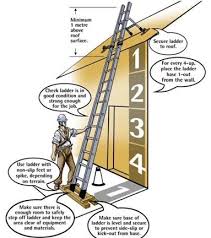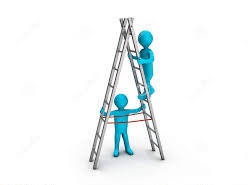Employees should follow certain rules when placing, ascending, and descending ladders which include:
• Hold on with both hands when going up or down. If material must be handled, raise or lower it with a rope either before going down or after climbing to the desired level.
• Always face the ladder when ascending or descending.
• Never slide down a ladder.
• Be sure shoes are not greasy, muddy, or slippery before climbing.
• Do not climb higher than the third rung from the top on straight or extension ladder, or the second tread from the top on stepladders.
• Carry tools on a tool belt not in the hand.
• Never lean too far to the sides. Keep your belt buckle within the side rails.
• Use a 4 to 1 ratio when leaning a single or extension ladder. (place a 12 foot ladder so that the bottom is 3 feet away from the object the ladder is leaning against.)
• Inspect ladder for defects before using.

• Never use a defective ladder. Tag or mark it so that it will be repaired or destroyed.
• Never splice or lash a short ladder together.
• Never use makeshift ladders, such as cleats fastened across a single rail.
• Be sure that a stepladder is fully open and the metal spreader locked before starting to climb.
• Keep ladders clean and free from dirt and grease.
• Never use ladders during a strong wind except in an emergency and then only when they are securely fastened.
• Never leave placed ladders unattended.
• Never use ladders as guys, braces, or skids, or for any other purpose other than their intended purposes.
• Never attempt to adjust a ladder while a user is standing on the ladder.
• Never jump from a ladder. Always dismount from the bottom rung.
